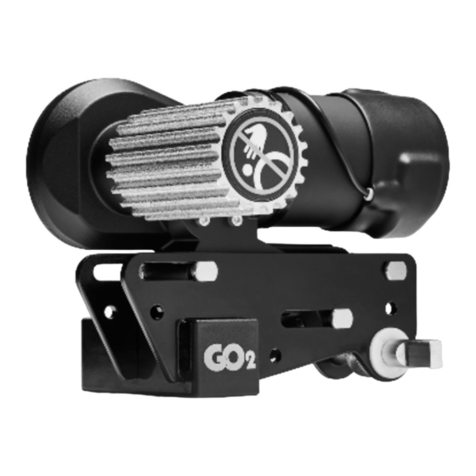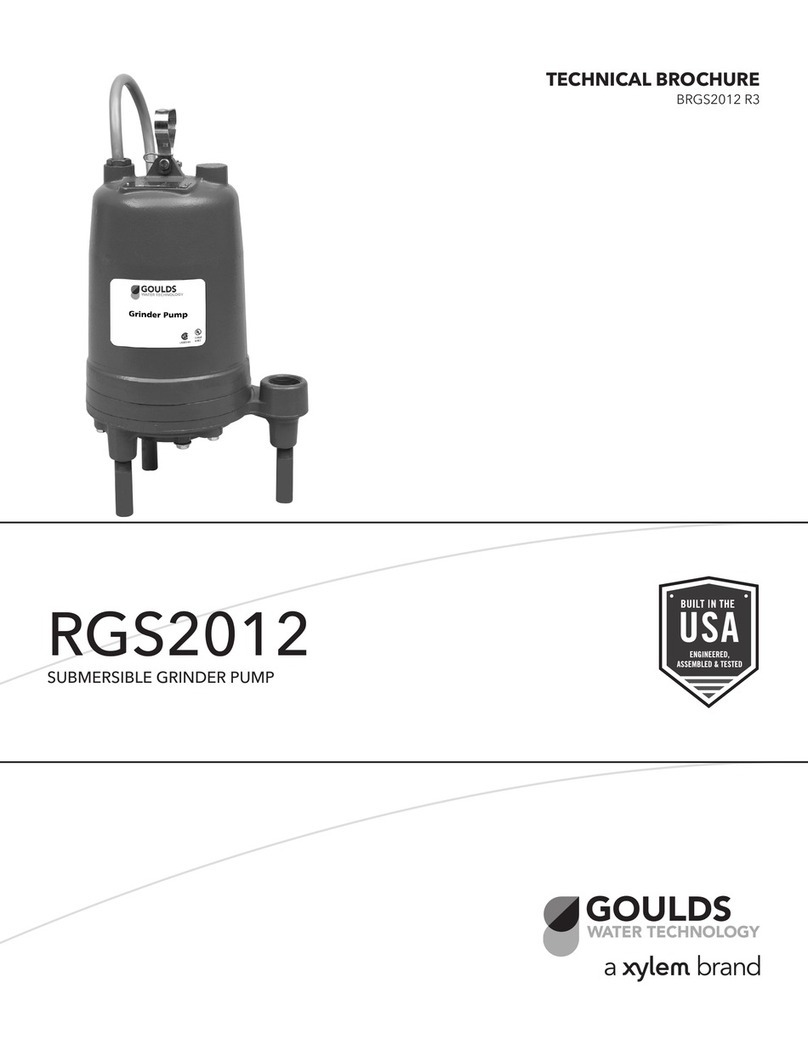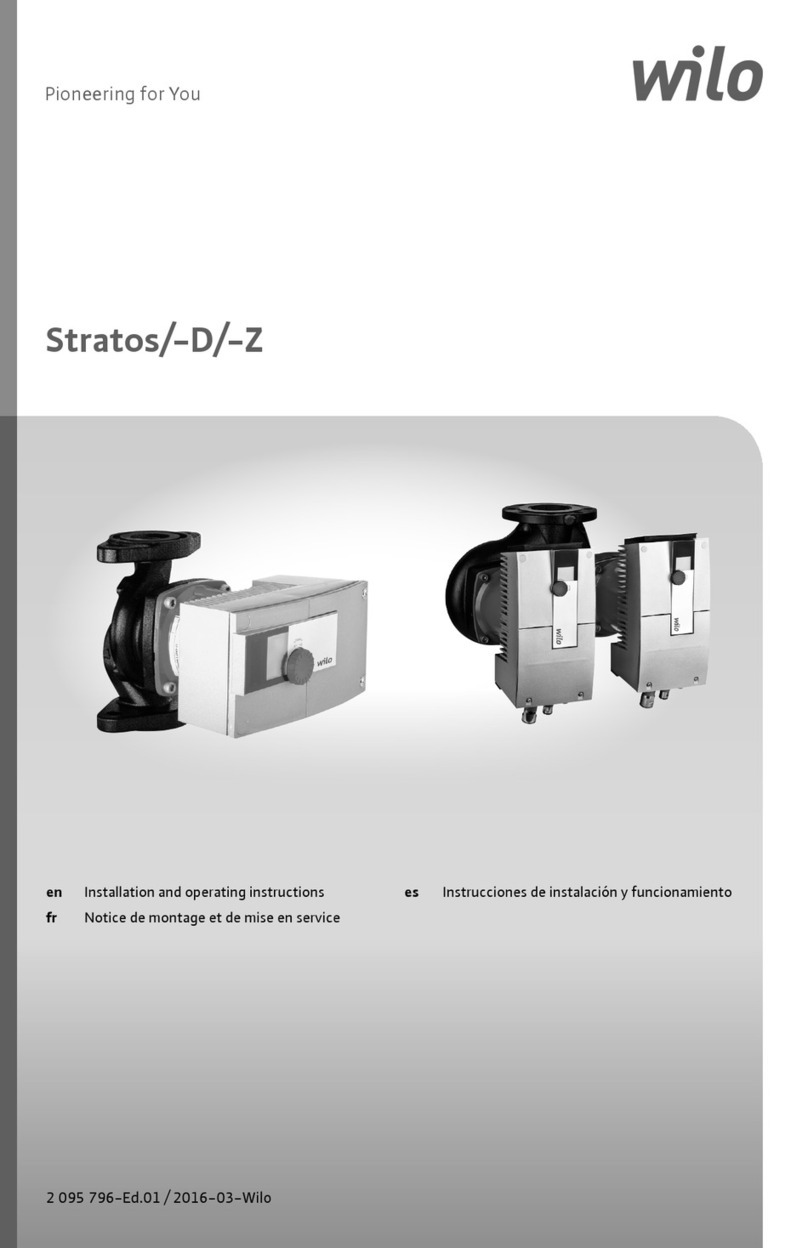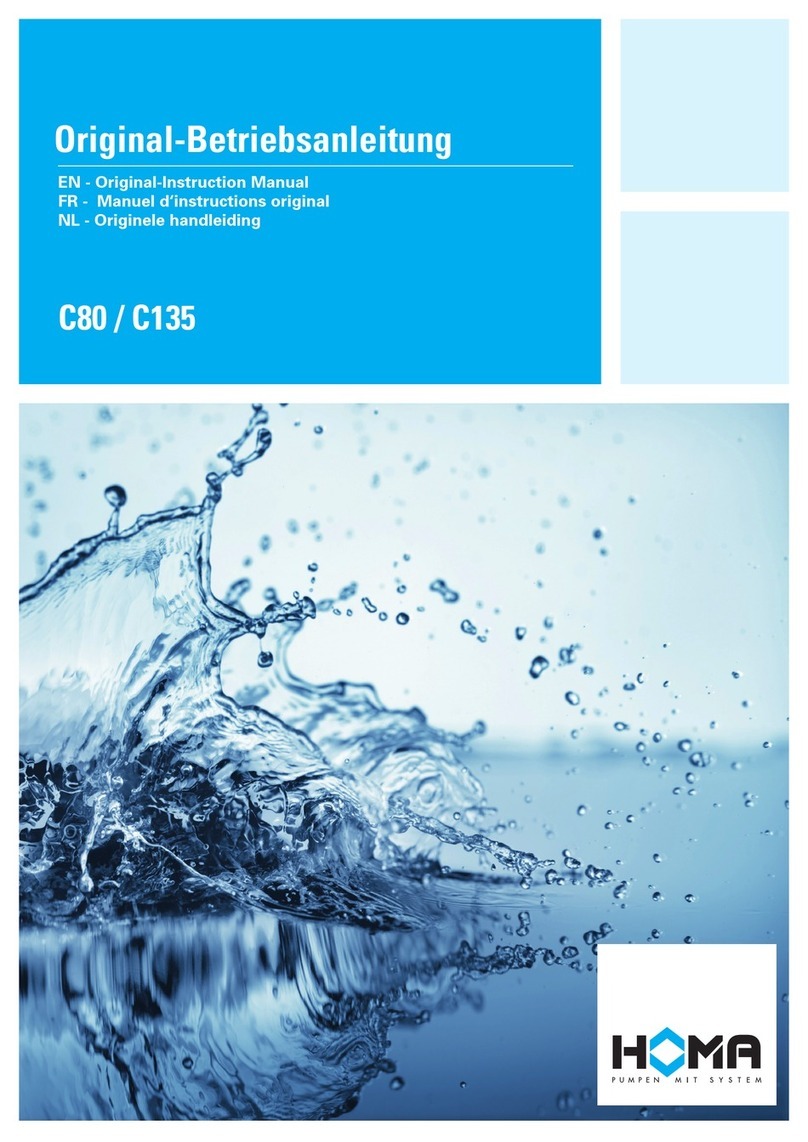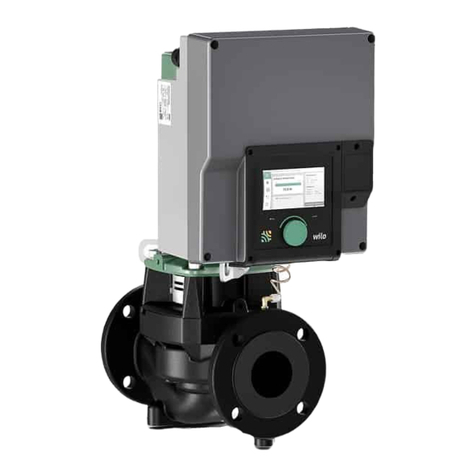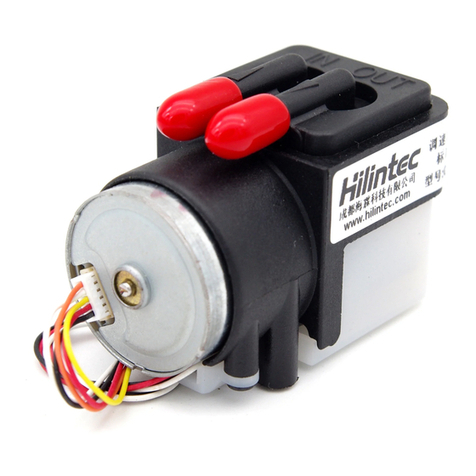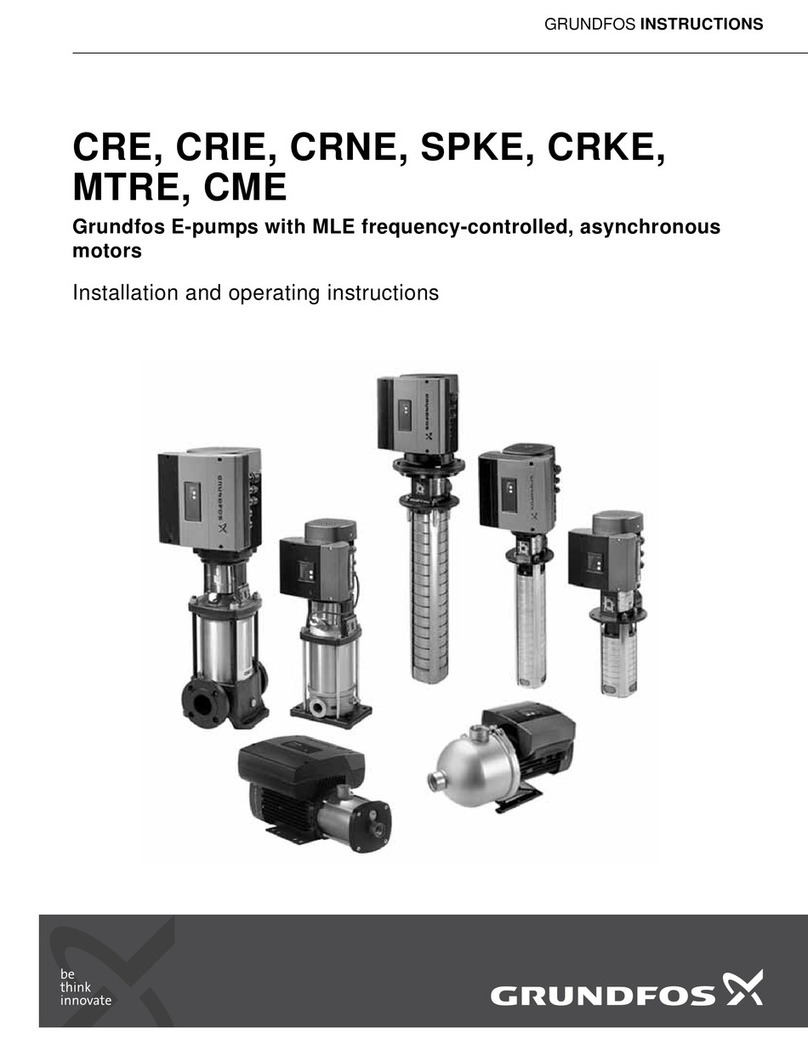IN-ECO ORV 8 User manual

1
Installation and
Operating Instructions
Rotary Vane Vacuum Pumps ORV
ORV 8, ORV 10, ORV 16, ORV 20, ORV 40, ORV 63, ORV 100,
ORV 160, ORV 200, ORV 250, ORV 300, ORV 630
IN-ECO, spol. s r.o.
Radlinského 13, 034 01 Ružomberok, Slovak Republic
Telefón: +421/44/4304662, Fax: +421/44/4304663
www.in-eco.eu, e-mail: [email protected]
www.in-eco.eu
Air and Vacuum
Components

2
TABLE OF CONTENTS
We reserve the right to change the product at any time without any form of notication. The information in this publication
is accurate to the best of our ability at the time of printing. Company IN-ECO will not be responsible for errors
encountered when attempting to perform tasks outlined in this publication which is copyright protected.
GENERAL
Identication 2
Operating Principles 2
1.0 INSTALLATION 2
1.1 Unpacking 2
1.2 Location 2
1.3 Power Requirements 2
1.4 Vacuum Connections and Drip Legs 3
1.5 Oil Filling 3
2.0 OPERATION 4
2.1 Start-up 4
2.2 Gas Ballast 4
2.3 Process Gas 4
2.4 Stopping Pump 5
3.0 ROUTINE MAINTENANCE 6
3.1 Pump Oil 6
3.1.1 Oil Filter 6
3.1.2 Oil Type and Quantity 6
3.1.3 Oil and Filter Change 6
3.1.4 Oil Flushing procedure 7
3.2 Automotive-Type Oil Filter 8
3.3 Exhaust Filter 8
3.4 Inlet Flange 8
3.5 Vacuum Inlet Filter (optional) 9
3.6 Routine Maintenance Schedule 9
3.7 Overhaul Kit/Filter 9
4.0 TROUBLESHOOTING 9
5.0 LIMITED STANDARD WARRANTY 14
Technical Data 14
Part list 15
Illustration of ORV 25 - ORV 40 16
Illustration of ORV 63-100 17
Illustration of ORV 160, 1200, 250, 300 18
Page

3
GENERAL
Identication
For model identication, see the nameplate mounted on the side of the exhaust box..
This manual is written to cover ORV versions of models ORV 20, ORV 40, ORV 63, ORV 100, ORV 160, ORV 200, ORV 250, ORV 300,
ORV 630. For example, it would appear as follows: ORV 20
When ordering parts, it is helpful to include the serial number from the nameplate.
Operating Principles
All reference (Ref. XXX) numbers listed in the text and on illustrations throughout this manual are related to the drawings and parts list
shown later in this publication.
All ORV Series, Single Stage, Rotary Vacuum Pumps are direct-driven, air-cooled, oil-sealed, rotary vane pumps that operate as positive
displacement pumps. They consist of a rotor positioned eccentrically in a cylindrical stator (see Fig. 1). The rotor has three radially sliding
vanes which divide the pump chamber into three segments. When the rotor spins, centrifugal force pushes the vanes, which glide in the
slots, towards the wall of the cylinder. The rotor has three vanes which divide the pump chamber into three segments. The gas to be
pumped enters at the inlet port, passes through the inlet screen and the open anti-suck-back valve into the pump chamber. As the rotor
rotates, the inlet aperture is closed, the gas is compressed and forced out through one-way valves between the pump cylinder and the
exhaust box. This operation is repeated three times each revolution.
1.0 INSTALLATION
1.1 Unpacking
Inspect the box and pump carefully for any signs of damage incurred in transit. Since all pumps are ordinarily shipped FOB our factory,
such damage is the normal responsibility of the carrier and should be reported to them.
Remove the nuts from the bottom of the box/crate and pull the pump out of the container, then unscrew the studs from the bottom of the
rubber feet.
The inlet port of the pump is covered with a plastic cap prior to shipment to prevent dirt and other foreign material
from entering the pump. Do not remove this cover until the pump is actually ready for connection to your system.
1.2 Location
The pump must be installed in a horizontal position on a level surface so that the pump is evenly supported on its rubber feet. Allow suf-
cient air space between the pump and any walls or other obstructions; adequate ventilation must be provided for the fans on the pump
and motor (i.e., do not locate the pump in a stagnant air location).
Whenever the pump is transported, be sure to drain the oil prior to shipping to avoid vane breakage when restarting the pump.
Do not tip the pump over if it is lled with oil.
Locate the pump for easy access to the oil sight glass (Ref. 83) in order to inspect and control the oil level properly. Allow clearance at the
exhaust ange area to provide service access to the exhaust lters.
1.3 Power Requirements
The schematic diagram for the electrical connection is located in the junction box or on the nameplate of the pump motor.
The motor must be connected according to the electrical codes governing the installation. The power supply must be routed through a
fused switch to protect the motor against electrical or mechanical overloads. The motor starter has to be set consistent with the motor
current listed on the motor nameplate.
If the pump is supplied with a manual motor starter, it is preset at the factory in accordance with the customer’s
specication. For other voltage requirements, contact the factory for motor and/or starter information.
Note: See the motor manufacturer’s manual for startup maintenance of the motor.
Correct direction of rotation is marked by an arrow on the motor fan housing and is counterclockwise when looking at the motor from the
motor‘s fan side.

4
Rotary Vane Vacuum Pump ORV 8
1 - Directional arrow
2 - Suction connection with non-return valve
3 - Gas discharge
4 - Exhaust cover
5 - Exhaust lter
6 - Oil ll plug
7 - Oil drain plug
8 - Oil sight glass
1 - Directional arrow
2 - Suction connection
3 - Gas discharge, Exhaust cover
4 - Exhaust lter
5 - Oil ll plug
6 - Oil drain plug
7 - Oil sight glass
1 - Directional arrow
2 - Suction connection
3 - Gas discharges
4 - Exhaust lter
5 - Oil ll plug
6 - Oil drain plug
7 - Oil sight glass
8 - Oil lter
Rotary Vane Vacuum Pump ORV 10 - ORV 20
Rotary Vane Vacuum Pump ORV 40 - ORV 300

5
CAUTION: After the electrical connection
has been made, but before the pump is
lled with oil, the rotation of the motor
must be checked. Open the inlet port and
jog the motor briey to make sure rotation
is correct. If it runs backwards and if it is
wired three phase power, reverse any two
leads of the three at the power connection.
CAUTION: The built-in, anti-suck-back valve
is not positive action; do not use it as a system
check valve.
1.4 Vacuum Connections and Drip Legs
Use a line size to the vacuum system that is at least as large as that of the pump inlet. Smaller lines will result in lower pumping speeds
than the rated values.
Install a drip leg and drain on the vertical pipe near the pump inlet. Also, when installing discharge piping, a drip leg should be installed.
Drain the drip legs often to remove any condensation which may have collected.
If more than one vacuum pump or a receiver tank is connected to a common main line, each pump should have its own manual or au-
tomatic operated shut-off valve or positive action check valve. The built-in, antisuck- back valve should not be used as a shut-off valve
for the vacuum system.
Remove the plastic protective cap from the inlet port prior to connection of the pump to the system. Vertical connection of the vacuum
line can be made directly to the pump inlet (Ref. 260).
Type and size of the inlet connections of the ORV Series pumps are shown in the TECHNICAL DATA page 14.
If the gas that is pumped contains dust or other foreign solid particles, a suitable inlet lter (10 micron rating or less) should be con-
nected to the inlet port. Consult the factory for recommendations.
1.5 Oil Filling
The pump is shipped without oil. After level installation, and after correct rotation has been established and with the pump switched
„off“ and secured against accidental start-up, ll the pump with the recommended vacuum oil through the oil lling port (Ref. 88), ob-
serving the „MAX“ and „MIN“ position at the oil sight glass (Ref. 83).
Non-detergent oil should be used. Do not use detergent motor oil as additives in detergent oil will plug exhaust lter elements and
shorten their life.
Exhaust lter
Exhaust
Inlet
Inlet screen
Anti-suckback valve
Vane
Rotor
Main oil feed line
Automotive type
spin-on lter
Oil sight glass
Exhaust valve
Oil return valve
Oil return line to inlet*
Gas ballast
Fig. 1 - Principle of ORV Pump

6
It is recommended that OV500 Series oil be used to receive the best performance from your vacuum equipment. OV500 Series oil is
a high quality vacuum oil that will give longer running time between oil changes, will provide better lubrication at high operating
temperatures, and will prolong the life of exhaust lter elements. This oil can be obtained directly from IN-ECO company.
The strict use of IN-ECO oils and parts from the day of purchase can extend the life of the vacuum pump.
For general applications, use OV530 in all models covered by this manual. Use OV590 or OV570 in pumps that are operated in high
ambient temperatures (above 90°F) or when the oil carbonizes (turns black) before the change interval.
Use OV590 or OV570 on ORV 250 pumps. Contact the factory for recommendations when using other oils.
OIL TECHNICAL DATA
Type oil OV530 OV568 OV570 OV590
Flash Point (COC)°, min.: °C 237 254 271 252
Pour Point, max.: °C -17 -43 -48 -12
Viscosity at 40°C (mm2/s) 106.2 79.27 108.74 120.8
Viscosity at 100°C (mm2/s) 11.3 7.91 16.15 12.5
Viscosity Index 91 63 145 100
The TECHNICAL DATA chart on page 14 gives the approximate quantities of oil required for each pump. The oil capacity chart should
only be used as a guide, since oil capacity may be slightly lower, depending on whether the pump was lled previously, and whether all
components such as oil lter, oil lines, etc., were allowed to completely drain. Use only the sight glass reading for proper level. Never
overll!
WARNING: Keep the oil ll plug tight as pressure in the exhaust box could cause bodily injury if
the plug is blown out. Do not ll/add the pump with oil through the exhaust/inlet ports as there is
danger of breaking the vanes!
For ambient operating temperatures lower than 5 °C, use OV580 synthetic oil. If this does not help (where the pump has difculty
starting due to high oil viscosity), contact the IN-ECO company.
Replace the oil ll plug (Ref. 88), making sure that the gasket (Ref. 89) is in place and properly seated and secured. Some pumps are
equipped with an exhaust pressure gauge as an integral part of the oil ll plug. Switch the power back into the „on“ position..
2.0 OPERATION
2.1 Start-up
Check rotation of the motor as described in Section 1.3.
- Power Requirements
Fill the pump with oil as described in Section 1.5.
- Oil Filling
Start the pump and immediately close the inlet. Run the pump for a few minutes before checking the oil level again. With the pump
shut off, the oil level should be visible in the oil sight glass (Ref. 83), between the „MIN“ and „MAX“ mark.
Add oil, if necessary, but only add it when the pump has been shut off and the circulating oil has had sufcient time to return to the oil
sump.
Note: The oil separated by the exhaust lter element forms droplets on the outside of the exhaust lter that collect at a low point in
the upper half of the exhaust box. From there the collected oil is drained back to the oil sump via an oil check valve (Ref. 275) which
opens on ORV model pumps when the pump is shut off. It is necessary to shut off the ORV model pumps after every 8 hours of opera-
tion to allow the check valve to open. If the pump is not shut off after this time period, it is possible to starve the pump of oil since the
oil is not allowed to drain back into the oil sump and/or oil droplets may be blown out of the exhaust. If the pump is operating at high
pressure it may be necessary to shut it down sooner than 8 hours.

7
2.2 Gas Ballast
All ORV Series pumps are equipped with a gas ballast valve. The gas ballast valve (Ref. 440) is located between the inlet port and
the exhaust box. ORV series pumps are equipped with a permanent gas ballast which cannot be shut off unless the sintered lter is
removed and the orice plugged. Larger pumps are equipped with an adjustable gas ballast valve.
The adjustable gas ballast valve should normally be left open. Its primary function is to prevent water vapor from condensing in the
pump. Condensation causes emulsication of the oil, loss of lubricity, and possible rotor seizure.
2.3 Process Gas
The ORV series pumps are designed to pump air and are not intended for use when water vapor is being pumped. In some applica-
tions, when the quantity of the water vapor is moderate, ORV pumps have been used with good results. On these occasions, the pump
is run until it is up to operating temperature before it is allowed to pump the process gas. The pump is also operated for a period of time
off process and on air (to clear it of process gas) before it is shut down. This operating technique prevents the vapor from condensing
in the pump. Before attempting to pump a gas laden with water vapor, contact IN-ECO company for advice.
2.4 Stopping Pump
To stop the pump, turn off the power. The pump has a built-in, anti-suck-back valve (Ref. 251 thru 255) to prevent the pump from
rotating backwards when it is shut off.
CAUTION: Do not use the anti-suck-back valve as a system check valve for your vacuum system.
Do not depend on the anti-suck-back valve to prevent pump oil from migrating through the inlet
into the system when the pump is shut down.
Install an automatic operated valve (such as a check valve) in front of the pump, if more than one pump is pumping on the same line or
if there is a sufcient volume of vacuum in the system to cause the pump oil to be drawn into the piping when that pump is shut down.
All ORV Series pumps are vented internally to atmospheric pressure through venting holes that are next to the exhaust valve assembly.
3.0 ROUTINE MAINTENANCE
ORV Series pumps require very little maintenance; however, to insure optimum pump performance, the following steps are recom-
mended.
3.1 Pump Oil
3.1.1 Oil Level
CAUTION: Do not add oil while the pump is running since hot oil vapor may escape through the
oil ll port.
CAUTION: Insufcient oil quantity in the pump has the potential, under certain conditions,
to lead to self-ignition of the remaining oil in the pump.
With the pump installed relatively level, make sure that there is sufcient clean oil in the pump. The oil level should be observed on a
daily basis and/or after 8 hours of operation and should be replenished if it drops below the 1/4 mark on the oil sight glass on pumps
with one sight glass.
On ORV Series pumps, you must rst shut the pump off in order to let the oil ow back into the oil sump prior to checking the sight
glass. Allowing insufcient time for the oil to drain back into the sump on ORV Series pumps prior to adding oil could result in overlling.
Oil level readings should be done only when the pump is turned off. Oil can be added to the oil ll port (Ref. 88) if the pump is shut off
and the circulating oil has sufcient time to return to the oil sump. The oil might appear to be foamy, which is a normal phenomenon
with aerated oil.
Under normal circumstances, it should not be necessary to add or drain oil from the pump between recommended oil changes.

8
A signicant drop in oil level means there is an oil leak or that an exhaust lter is broken, and the pump should be smoking excessively.
It is normal for the oil to be foamy and light in color in an operating pump. However, if the oil is milky colored, it is an indication
that water is present in the oil. Normally, by operating the pump for an extended period, with the inlet suction blanked off and the gas
ballast (Ref. 440) open on ORV pumps, the water will be purged from the oil. If the oil is dark colored, it is contaminated or carbonized
and must be changed. Depending on the severity of the contamination, a thorough ushing may be needed. Contact the IN-ECO
company for ushing oil (OV 568) and refer to Section 3.1.4 for the ushing procedure.
3.1.2 Oil Type and Quantity
See Section 1.5 - Oil Filling for details on oil type and quantity.
3.1.3 Oil and Filter Change
CAUTION: When changing the oil and lters, it may be necessary to ush the pump to remove any
build-up of degraded oil from the sumps, oil lines, radiators, etc., to ensure proper oil ow through
the pump. Reduced oil ow, especially through radiators and cooling coils, can cause mechanical
damage or extreme overheating, which could cause the oil vapors to ignite.
WARNING: Always take the necessary precautions concerning personal protective equipment
when changing oil and make sure the pump is switched to „off“ so that accidental starting will
not occur. Oil temperature can reach 100 °C and may pose a danger of scalding.
See Section 1.5 and the Technical Data on page 14 for details on oil type and quantity.
Check the oil for contamination on a weekly basis by shutting the pump off and draining some of the oil into
a small glass or a similar transparent container through the oil drain port (Ref. 95).
Oil life is dependent upon the conditions to which it is exposed. A clean, dry air stream and an oil operating temperature under 99 °C
are ideal conditions. When using OV530 (hydrocarbon oil), it is recommended that oil changes are made every three (3) to four (4)
months or 500 to 750 hours of operation, or as necessary if high heat is contaminating the oil. The use of OV570 (synthetic) or OV590
(semi-synthetic) oil may signicantly extend the operating hours between oil changes under ideal conditions. However, you may need
to ush out the pump before changing. Contact the factory Service Department for advice. Oil samples should be taken regularly when
exceeding the 500-750 hour recommendation.
Excessive Heat
When the pump is subjected to operating conditions that will cause the oil to be heated above 99 °C, the oil will carbonize and become
contaminated after a relatively low number of operating hours. The higher the temperature, the quicker the oil becomes contaminated.
If the oil temperature is too severe, OV570 (synthetic) or OV590 (semi-synthetic) oil should be used to withstand the elevated tempera-
tures. If synthetic oil is used, the pump should be ushed with OV568 oil. Contact the factory for instructions on the ushing procedure.
Auxiliary oil cooling is the most practical approach to a severe heating problem.
Contaminated Air Stream
When the air stream contains a solid and/or liquid that can contaminate the oil, it must be changed more often. If the air stream con-
tains a small percentage of contaminates and/or they are slightly aggressive* (mild acids, etc.), synthetic oil, such as OV570, will resist
breakdown better than the standard OV530. The solution is to install a lter or knock-out pot to keep the contaminates out of the pump.
*Process air streams with a large percentage of contaminates and/or more than slightly aggressive contaminates must use a chemical duty pump.
Oil change intervals can only be established by experience with the pump operating in the actual conditions (see previous paragraph
for some of the conditions). Develop the oil change interval by periodically checking an oil sample removed from the pump. When the
oil sample has become dark in color (from solids and carbonized particles) or is milky looking (from water), it is time to discard it. As
mentioned before, a thorough ushing may be required.

9
3.1.4 Oil Flushing Procedure
Flushing is needed under certain conditions. Some pumps will be beyond ushing and will need to be overhauled.
To help determine if ushing is needed, observe the condition of the oil as it is drained from the pump. Is it black and tar like or contami-
nated in any way? Was the pump noisy, overheating, or was the motor overload shutting the pump off? How old is the pump and when
was the last time the oil was changed?
If the above conditions exist or you don‘t know when the last oil change was performed further investigation is needed. Also, when
changing from one oil type such as OV530 to another type such as OV590 or OV570 it will be benecial to ush. Although the oils are
compatible, mixing a lesser grade oil such as OV530 with a synthetic oil like OV570 will reduce the effectiveness of the synthetic oil.
All of the oil will be removed and replaced with the ushing oil (OV568), and eventually that will be replaced by whatever OV oil is
needed for your particular application. Have enough oil and oil lters on hand for a couple of ushes. The following describes the steps
in the ushing procedure:
Shut the pump off and drain all the oil from the pump and remove the access plates (Ref. 205) from the exhaust box (Ref. 075). Remo-
ve the metal bafe (Ref. 078) and take a good look at the internal walls of the oil sump. If the walls are discolored but have no build up
of any kind one can proceed with the ushing. If gelled or burnt oil is clinging to the walls this material must be scraped and removed
prior to ushing. Proceed by scraping and cleaning as much of the exhaust box as possible. The more debris that is removed now the
more effective the ushing will be later. Re-install the metal bafe, cover and proceed with the ushing. At this point one must remem-
ber that the oil lines and oil cooler might also be plugged to a point where no amount of ushing will make a difference and a complete
overhaul will be the only option. Depending on the severity of the oil contamination ushing may be a last ditch effort.
Drain all of the oil from the pump. The more contaminated oil you remove now the more effective the oil ushing will be.
Remove the oil lter (Ref. 100) and install a new one. It is recommended that you do not change the exhaust lter
or lters until after the ushing to prevent contamination of any new lters.
Fill the exhaust box with the proper amount of ushing oil (OV-568).
If possible run the pump with the inlet closed and off of the process. Run the pump for approximately six hours, shut the pump off and
drain a small sample of oil into a clear container.
Examine it. If it is clear to amber run the pump for another six hours and examine it again. If after the rst six hours it is black drain it
and ll again using another new oil lter.
If after the second ushing the oil still remains black the pump may have too much contaminated oil in it to ush out properly. There
may be residue remaining in the lines and cooler that will not ush out. An overhaul will be necessary.
If after the second six hour period the oil still remains clear to amber in color drain it, change the oil lter and ll with the regular oil. At
this point also change the exhaust lters.
Run the pump with a fresh charge of the oil to be used in your application (not OV-568), and monitor the operating
conditions closely. Check for noise, overheating and oil condition until a regular oil change schedule can be established.
Do not let the oil turn black. Change it before it fails. If the oil is kept in good condition the pump will last for years. If the oil starts to
turn black do not hesitate to ush again. Keeping on top of the oil changes will prevent costly overhauls.
3.2 Automotive-Type Oil Filter
The pump is equipped with an automotive-type oil lter (Ref. 100). When replacing the automotive-type oil lter,use only a IN-ECO
company genuine lter.
Note: Make sure to tighten the IN-ECO oil lter securely against the aluminum sealing surface so that leaks will not occur.

10
3.3 Exhaust Filter
WARNING: If the gas entering this pump is a health hazard, use rubber gloves and all necessary
personal protection equipment when performing the exhaust lter replacement operation.
Every nine (9) to twelve (12) months, or as necessary, replace the exhaust lter elements. The service life of the exhaust lters varies
widely with pump application. It is only necessary to change the lters when the elements become clogged with foreign material or burned
oil. Indications of clogged lters are smoke and oil mist coming from the pump exhaust, higher than normal motor current or oil leaking
from the gas ballast valve on ORV models.
In order to replace the lter, remove the four socket head cap screws (Ref. 146 on 0025 through 0101 / Ref. 142 0n 0250) and lockwashers
(Ref. 143) retaining the exhaust port housing (see Fig. 3). Pull the housing off the exhaust box and set it aside. Use a slotted head
screw driver to loosen the exhaust lter retaining spring, then rotate and remove the spring (see Fig. 4). Pull the lter cartridge (Ref. 120)
out of the exhaust box.
WARNING: Wear safety glasses when installing or removing the spring retainers. The retainers can, if not
secured correctly, slip off and y out of the exhaust box.
To eld test an exhaust lter element, remove it from the pump, allow it to cool, clean the sealing end (or Oring end), and use compressed
air to blow through the element. Apply approximately 3 to 6 psi (maximum allowable operating pressure across the lter)..
WARNING: Do not inhale through the lter or allow your mouth to come in direct contact with the lter.
Fig. 3 - Removing the Exhaust Housing Fig. 4 - Removing the Filter Spring
Use a shop rag to seal off the connection between the air hose and the lter. If you can blow through it, the element is good. If not, discard
it and install a new one. The lter cannot be cleaned successfully. Visually inspect the lter element for cracks.
Reinstall the lter elements. Make sure the open end of the element is properly seated down in its recess in the exhaust box with the
O-ring (Ref. 121) correctly positioned. Retain the lter with the spring clip, tighten the tension screw until the lter is secure. Place the
exhaust port gasket and cover in position on the exhaust box and retain with the cap screws.
3.4 Inlet Flange
The standard inlet ange assembly contains an inlet screen (Ref. 261) which may require occasional cleanly. The frequency of cleaning
can only be determined by experience and is affected by hours of operation and particle size being trapped. An optional vacuum inlet lter
is offered and can help minimize the need or frequency of cleaning the inlet screen.
To clean the screen, disconnect the ange from the process piping. Remove the four screws and lockwashers (Ref. 265/266). Remove
the inlet ange (Ref. 260). Remove the screen (Ref. 261) and clean with compressed air. After cleaning, install the screen and
inlet securing them with the screws and lockwashers. Make sure the O-ring (Ref. 265) is in place prior to securing the screws. Reattach
the process piping to the inlet.

11
3.5 Vacuum Inlet Filter (optional)
If the pump is equipped with a special vacuum inlet lter in applications where powder, dust or grit is present, the lter cartridge should
be cleaned on a weekly basis, or as required, depending on the amount of foreign particles to which the pump is exposed.
3.6 Routine Maintenance Schedule
Note: Lack of proper maintenance can result in blocked lters, radiators, oil lines, etc. This condition can lead to excessive heat cau-
sing mechanical failure or ignition of the oil vapors.
Daily: Visually check oil level (see 3.1.1 and 3.1.2).
Weekly: Check oil for contamination (see 3.1.3). Inspect inlet lter (see 3.5).
Every three (3) or four (4) months, 500 to 750 hours of operation, or as necessary: See 3.1.3 and 1.5. Drain and
discard oil from the hot pump. Replace the automotive-type oil lter and rell with fresh oil through the ll plug (see 3.1.2 through 3.1.3
and 3.2).
Every three (3) to nine (9) months, or as necessary: Replace exhaust lter elements (see 3.3).
As necessary: Check and/or clean the standard inlet screen. If the optional inlet lter is used, replace the l ter material as practice
determines.
The radiator (Ref. 241) on model 0250, the fan cover (Ref. 340) on the 0025 through 0101 models and (Ref. 244) on the 0250 model
should be inspected regularly for debris. Soiling prevents cool air intake and may lead to overheating of the pump.
Drain drip legs on inlet and exhaust piping.
3.7 Overhaul Kit/Filter
An overhaul kit containing a set of gaskets and O-rings, vanes, bearings and bearing sleeves, shaft seals and taper pins, is available
from the factory.
Also, a lter kit containing oil drain plug, gaskets, automotive-type oil lter (where applicable), exhaust lter, and synthetic bafe stra-
iner (where applicable), is available from the factory.
When ordering, please specify pump size and model, and serial number.
4.0 TROUBLESHOOTING
4.1 Trouble
Pump does not reach „blank-off“ pressure, which is the lowest absolute pressure (best vacuum) when run-
ning with the inlet closed via a blank ange or a valve; or the pump takes too long to evacuate the system.
Blank-off pressure can be measured by using a good quality capsule gauge.
Possible Cause: Contaminated oil is the most common cause of not reaching the ultimate pressure.
Remedy:
Shut off pump, after operating temperature has been reached, drain the warm oil from pump and exchange automotive-type oil lter
(where applicable), if necessary. Flush and ll pump with new oil and take new blank-off measurement after operating temperature is
reached (at least 20-30 minutes).
Possible Cause:
Vacuum system or vacuum piping not leak-tight.
Remedy:
Check hose and pipe connections for possible leak.
Possible Cause:
Wire mesh inlet screen plugged (Ref. 261).
Remedy:
Clean wire mesh inlet screen. Install inlet lter if problem repeats frequently.

12
Possible Cause:
No oil or not enough oil in oil reservoir.
Remedy:
Shut off the pump, add the necessary oil, or if oil seems contaminated, drain balance of oil from pump, exchange automotive oil lter, and
rell with fresh oil. Flush if necessary.
Possible Cause:
Automotive-type oil lter is dirty or clogged (where applicable).
Remedy:
Replace automotive-type oil lter, exchange oil, if necessary, and rell with fresh oil.
Possible Cause:
Inlet valve plate (Ref. 251) stuck in closed or partially open position due to contamination.
Remedy:
Disassemble inlet valve and screen. Clean as required.
Possible Cause:
Oil tubing ttings are loose and leaking.
Remedy:
Replace or retighten the oil ttings or oil tubing. Replace only with same size tubing.
Possible Cause:
Shaft seal leaking.
Remedy:
Replace the shaft seal following disassembly and assembly steps outlined in the Maintenance and Repair Manual. Check the shaft
seal. It should have a spring installed inside and around the shaft sealing lip.
Possible Cause:
Exhaust valve (Ref. 159) is not properly seated or it is partially stuck open (ORV models only).
Remedy:
Follow disassembly and assembly steps outlined in the Maintenance and Repair Manual or contact the nearest IN-ECO Service Center.
Possible Cause:
Vanes are blocked in the rotor or they are damaged.
Remedy:
Free vanes or replace with new ones following disassembly and assembly steps outlined in the Maintenance and Repair Manual or con-
tact the nearest IN-ECO Service Center.
Possible Cause:
Radial clearance between the rotor and cylinder is no longer adequate.
Remedy:
Follow disassembly and assembly steps outlined in the Maintenance and Repair Manual on resetting the radial clearance correctly or
contact the nearest IN-ECO Service Center.
Possible Cause:
Internal parts worn or damaged.
Remedy:
Follow disassembly and assembly steps outlined in the Maintenance and Repair Manual and replace worn or damaged parts or contact
the nearest IN-ECO Service Center.

13
4.2 Trouble
Pump will not start:
Possible Cause:
The motor does not have proper supply voltage or is overloaded; motor starter overload settings are too low or wrong setting; fuses
are burned; or wire is too small or too long, causing a voltage drop to the motor.
Remedy:
Check correct supply voltage; check overload settings in motor starter for size and setting according to motor nameplate data; check
fuses; and install proper size wire. If ambient temperature is high, use larger size overloads or adjust setting 5% above nominal motor
nameplate value.
Possible Cause:
Pump or motor is blocked.
Remedy:
Remove fan cover and try to turn pump and motor by hand. If frozen, remove motor from pump and check motor and pump separately.
If pump is frozen, disassemble completely per the Maintenance and Repair Manual and remove foreign objects in the pump or replace
broken vanes.
4.3 Trouble
Pump starts, but labors and draws a very high current.
Possible Cause:
Oil too heavy (viscosity too high) or ambient temperature below 5 degrees C (41°F).
Remedy:
Change to OV580 vacuum oil if very cold, or warm up oil before starting the pump.
Possible Cause: Pump runs in the wrong direction.
Remedy:
Check for correct rotation which is counterclockwise when looking at the motor from the motor‘s fan side. Reverse any two leads on
the motor to change the direction of rotation.
Possible Cause: Pump is overlled with oil or wrong kind of oil is used.
Remedy:
Correct the oil level and quality per Section 1.5 and use recommended motor oil.
Possible Cause: Exhaust lters in exhaust chamber are clogged and appear burned black with pump oil.
Remedy: Replace exhaust lters, maintain proper oil condition, oil level, and use only iN-ECO recommended vacuum oil and
lters.
Possible Cause: The exhaust lter is clogged due to process material.
Remedy: Contact the IN-ECO company, for recommendations or proper lter cartridge.
Possible Cause:
Loose connection in motor terminal box; not all motor coils are properly connected. Motor operates on two phases only.
Remedy:
Check motor wiring diagram for proper hookup, especially on motors with six internal motor windings, tighten and/or replace loose
connections
Possible Cause: Foreign particle in pump; the vanes broken; the bearing is seizing.
Remedy:
Follow disassembly and assembly steps outlined in the Maintenance and Repair Manual and remove foreign
parts, and replace vanes and bearings or contact the nearest IN-ECO Service Center..

14
4.4 Trouble
Pump discharges smoke at the exhaust port or expels oil droplets from the exhaust.
Possible Cause:
Exhaust lter is not properly seated with O-ring (Ref.121) in lter base or lter material is cracked.
Remedy:
Check condition and check for proper seating of exhaust lters. Replace if necessary. Also, check lter spring clips for tightness.
Possible Cause: Exhaust lter is clogged with foreign particles.
Remedy: Replace exhaust lter.
Possible Cause:
The oil return valve (Ref. 275) is stuck open on ORV pumps. Proper function is that when blowing into check valve, it should close.
When applying vacuum on it, check valve should open.
WARNING: Do not apply pressure or vacuum by mouth.
Remedy:
Free or replace the oil return check valve.
Possible Cause:
If ORV Series vacuum pumps run continuously over 8 hours without ever being shut down, it may be possible that oil accumulates
behind the exhaust box cover to the extent that oil is blown out of the exhaust with the exhaust gas.
Remedy:
Shut pump down during break periods or install an additional oil return line assembly. Check that oil return valve (Ref. 275) is free and
drains oil back into the pump when the ORV Series pump is stopped.
4.5 Trouble
Pump runs very noisily.
Possible Cause: Coupling insert worn.
Remedy: Replace coupling insert in motor/pump coupling.
Possible Cause: Bearing noise.
Remedy: Follow disassembly and assembly steps outlined in the Maintenance and Repair Manual and replace bearings.
Possible Cause: Vanes stuck.
Remedy: Follow disassembly and assembly instructions outlined in the Maintenance and Repair Manual and replace
vanes. Use only recommended IN-ECO oil and change oil more frequently.
4.6 Trouble
The pump runs very hot. See Technical Data for typical oil sump temperature.
Note: The oil temperature with a closed inlet should be approximately 85-107°C depending on pump type. At 812 mbar, the oil in the
pump can go above 107 °C.
These values are taken at an ambient temperature of 20 °C. The maximum recommended ambient operating temperature for an ORV
is 38 °C on a continuous basis. When it is necessary to operate a pump in ambient temperatures above this limit, careful oil monitoring
and/or optional water cooling is necessary. Contact the factory for details.
Possible Cause: Not enough air ventilation to the pump.
Remedy: Clean motor and pump air grills. Do not install the pump in an enclosed cabinet unless a sufcient amount of cool air is
supplied to the pump. On pumps with oil cooling coils, clean outside n assembly. Bring ambient air temperature down.
Possible Cause: Automotive-type oil lter clogged and pump does not receive enough oil.
Remedy: Change automotive oil lter.
Possible Cause: Not enough oil in oil reservoir, or badly burned oil is used for pump lubrication.
Remedy: Drain and rell only with IN-ECO company recommended oil. Increase oil change intervals.
Note: On some high temperature applications, it may be necessary to change to a high temperature oil such as OV590 or OV570.
Contact the factory for recommendations.

15
4.7 Trouble
Pump is seized.
Possible Cause: Pump operated without oil and vanes are broken.
Remedy: Disassemble and exchange vanes as outlined in the Maintenance and Repair Manual or contact the nearest
IN-ECO Service Center..
Possible Cause: Pump was operated for an extended period of time in the wrong rotation.
Remedy: Inspect vanes and replace.
Possible Cause:
Liquid carryover into the pump cylinder broke vanes while pump was running, or oil broke vanes on start-up.
Remedy:
(a) Install condensate trap on the inlet of the pump.
(b) Pump was overlled with oil in oil reservoir. Follow oil lling procedure (see Section 1.5) and do not overll.
(c) Built-in, anti-suck-back valve (Ref. 250 through 255) leaking while pump was shut down and vacuum was left in manifold. Clean
valve seat and check that anti-suck-back valve holds vacuum on inlet when pump is shut down.
(d) Two pumps or a receiver is on the same main line. Install a manual or automatic operated valve in front of each pump.
4.8 Trouble
Automotive-type oil lter (Ref. 100) does not get warm within two to ve minutes when cold pump is star-
ted.
Possible Cause: Automotive-type oil lter is clogged.
Remedy: Replace automotive-type lter per Section 3.2 and exchange oil per Section 1.5.
Possible Cause
Wrong automotive-type lter is used and/or oil lines and oil coolers leading to pump are clogged.
Remedy:
Use only automotive lter as listed in Section 3.2 and blow lines free. Flush oil cooler.
Possible Cause:
The oil cooler (Ref. 241) is plugged internally with burnt oil (0250 models).
Remedy:
Remove the oil cooler and ush. Pump may have to be disassembled completely to correct a severely contaminated condition.

16
5.0 LIMITED STANDARD WARRANTY
IN-ECO company warrants that all products furnished by it are free from defects in material and workmanship at the time of shipment
for a period of 18 months from the date of shipment, or 12 months from the date of installation, whichever occurs rst. Claims must be
made during that period and are limited to the replacement or repair of parts claimed to be defective..
In the case of components purchased by IN-ECO company , such as starters, controls, mechanical seals, motors, couplings, etc., the
warranty of that manufacturer will be extended to the purchaser in lieu of any warranty by IN-ECO company. The replacement of wear
items including, but not limited to, seals, bearings, couplings, exhaust cover gaskets, oil drain plugs, oil ll plugs etc., made in connec-
tion with normal service are not covered by this Warranty.
The Limited Standard Warranty is valid only when the product has been properly installed, used in a normal manner, and serviced
according to the operating manual. This warranty shall not extend to products that have been misused, neglected, altered, or repaired
without factory authorization during the warranty period. We highly recommend the use of IN-ECO oils and parts to achieve docu-
mented performance and efcient operation. The use of oils or parts other than IN-ECO could limit the life expectancy of the equipment
and could void any warranties if they are the cause of any damage. Operating conditions beyond our control such asimproper voltage
or water pressure, excessive ambient temperatures, or other conditions that would affect the performance or life of the product will
also cause the warranty to become void.
Permission to return parts for warranty repair must be obtained, and all returns must be prepaid to the factory. If, after examination,
the product or part is found to be defective, it will be repaired or replaced on a no-charge basis and returned, FOB the factory. If it is
determined that the Warranty has not been breached by IN-ECO company, then the usual charges for repair or replacement will be
made, FOB the factory. Parts or products that are obsolete or those made to special order are not returnable.
This Limited Standard Warranty applies only to the above and is for the period set forth. IN-ECO company‘s maximum liability shall not,
in any case, exceed the contract price for the product, part, or component claimed to be defective; and IN-ECO company assumes no
liability for any special, indirect, or consequential damages arising from defective equipment.
THERE ARE NO WARRANTIES IMPLIED OR EXPRESSED THAT EXTEND BEYOND THOSE CONTAI-
NED IN THIS LIMITED STANDARD WARRANTY.
Technical parameters
Notes: *Because various motor types might be available and/or used on your specic pump, you should always refer to the motor nameplate
to verify HP, volts, amps, frame size, etc. or consult the factory.
Type
Nominal
pumping
speed
(m³/h)
Ultimate
pressure
ABS
(mbar)
Nominal
motor
rating
(kW)
Nominal
motor
speed
(min-¹)
Noise level
(ISO 2151)
(dB)
Oil
capacity
(l)
Weight
approx.
(kg)
Dimesions
(L x W x H)
(mm)
Gas
inlet /
outlet
Three phases
ORV 08 8 2 0,37 2800 60 0.25 11 330 x 165 x 152 G 3/8”
ORV 10 10 20,37 2800 69 0.30 18 340 x 210 x 205 G 1/2”
ORV 16 16 2 0,55 2800 69 0.30 18 340 x 210 x 205 G 1/2”
ORV 20 20 2 0.75 3000 66 0.45 20 338 x 232 x 220 G 3/4”
ORV 40 40 0.1 1.1 1500 65 1. 38 640 x 285 x 262 G 1¼”
ORV 63 63 0.1 1.5 1500 67 2 55 635 x 406 x 289 G 1¼”
ORV 100 100 0.1 2.2 1500 67 2 73 736 x 406 x 289 G 1¼”
ORV 160 160 0.1 4.0 1500 70 5 140 854 x 492 x 411 G 2”
ORV 200 200 0.1 4.0 1500 72 5 140 854 x 492 x 411 G 2”
ORV 250 250 0.1 5.5 1500 72 6.50 190 1000 x 581 x 410 G 2”
ORV 300 300 0.1 7.5 1500 74 6.50 190 1075 x 565 x 421 G 2”
ORV 630 630 0.1 15 1000 77 15 700 1723 x 912 x 726 G 3”
Single phase
ORV 08-1 8 2 0,55 2800 60 0.25 11 330 x 165 x 152 G 3/8”
ORV 10-1 10 20,55 2800 69 0.30 18 340 x 210 x 205 G 1/2”
ORV 16-1 16 2 0,75 2800 69 0.30 18 340 x 210 x 205 G 1/2”
ORV 20-1 20 2 0.75 3000 66 0.45 20 338 x 232 x 220 G 3/4”

17

18
Ref Description
1 Cylinder
15 Rotor
22 Vane
26 Cylinder cover
46 Plug
48 Socket set screw
49 O-ring
50 O-ring
52 Cylinder cover screw
54 Lock washer
57 Lock washer
59 Cylinder cover screw
65 Shaft key
75 Oil separator
83 Oil sight glass
84 Oil sight glass seal
88 Plug
89 Sealing ring
95 Plug
96 O-ring
120 Exhaust lter
121 O-ring
125 Spring
141 Separator gaskat
145 Exhaust cover
146 Cylinder cover screw
159 Exhaust valve
181 Plug
182 Sealing ring
183 Plug
184 Sealing ring
185 Seal
186 Foam
187 Lock washer
189 Stud
191 Hexagon nut
250 Valve case
251 Valve disk
252 Valve guide
253 O-ring
253.1 O-ring
254 Compression spring
256 Inlet ange seal
258 Guard ring
260 Inlet ange, vertical
260.1 Inlet ange, horizontal
261 Screen
265 Inlet ange screw
266 Washer
275 Oil return screw
285 Oil return valve
288 Sealing ring
290 Oil line
400 Motor (50,60Hz)
400.1 Motor endplate
400.2 Ball bearing
400.3 Fan blade
400.4 Motor fan cover
400.5 Shaft seal
400.6 Terminal box
405 Plate
406 Screw
407 Washer
Ref Description
408 Hexagon nut
409 Rubber plate
430 Name plate
431 Arrow label
440 Gas ballast
Parts List for models ORV 10 a ORV 16

19
ORV 10
ORV 16

20
Ref Description
1 Cylinder
5 Socket set screw
15 Rotor
18 Bearing sleeve
22 Vane
25 Endplate, motor side
26 Endplate, fan side
30 Bearing
31 Spacer, bearing to Seal
35 Shaft seal
42 Retainer ring
43 Screw, hex head
46 Gasket-ring
47 Plug
49 O-ring
50 O-ring
53 Screw, hex head
54 Lockwasher
57 Hex head screw
58 Lockwasher
60 Taper pin
63 Plug
64 Gasket-ring
65 Shaft key
66 Shaft key
75 Exhaust box
78 Bafe, expanded metal
79 Demister pad
80 Sheet metal bafe
83 Oil sight glass
84 Gasket ring, sight glass
88 Oil ll plug
89 Gasket ring, ll plug
90 Exhaust pressure gauge
95 Oil drain plug
96 O-ring
99 Pipe nipple
100 Oil lter
105 Cover, exhaust box
106 Gasket, exhaust box cover
107 Screw, exhaust box
108 Lockwasher
115 Exhaust lter bracket
120 Exhaust lter
121 O-ring
125 Filter spring assembly
126 Filter spring screw
130 Strainer
136 Gasket, exh. box service block
137 Lockwasher
138 Screw
139 Service block
140 Exhaust cover plate
141 Exhaust cover gasket
142 Socket head cap screw
143 Lockwasher
144 Retaining ring
145 Housing, exhaust port
146 Screw, exhaust housing
148 Service block oil bafe
149 Socket head cap screw
150 Lockwasher
Ref Description
151 Exh. Screen, coarse
152 Exh. Screen, ne
159 Valve assembly, exhaust
161 Oil service block
162 Oil service block gasket
163 Hex head cap screw
164 Lockwasher
165 Socket head cap screw
166 Lockwasher
168 O-ring
169 Exhaust valve cover plate
175 Socket head cap screw
176 Lockwasher
185 Gasket, cylinder/exhaust box
186 Stud
187 Lockwasher
189 Stud
190 Lockwasher
191 Nut
205 Exhaust cover side plate
206 Cover plate gasket
207 Socket head cap screw
208 Lockwasher
221 Hydraulic tting banjo
222 Hydraulic tting, straight
223 Hydraulic tting, elbow/banjo
224 Pipe adapter
225 Hydraulic tting
230 Oil tubing
231 Oil tubing
232 Oil tubing
238 Socket head cap screw
239 Lockwasher
241 Oil cooler
242 O-ring
244 Fan cover
247 Socket head cap screw
250 Housing, lower, inlet
251 Valve plate, inlet
252 Valve plate guide
253 O-ring
254 Spring, valve plate
255 O-ring
260 Inlet ange, upper
261 Inlet screen
265 Screw, hex head cap
266 Lockwasher
270 Plug
271 Gasket ring
275 Oil return valve
276 Gasket ring
284 Hydraulic, tting banjo
285 Screw, oil recirculation
286 Banjo tting housing
288 Gasket ring
289 Screw
290 Oil return line, RA version
291 Hyd. tting, straight
292 Carburetor jet
293 Oil return line, RC version
297 Screen fan guard
300 Motor mounting bracket
Ref Description
301 Screw hex head cap
302 Lockwasher
306 Motor adapter ange
307 Lockwasher
311 Coupling half, pump side
312 Coupling insert
313 Coupling half, motor side
315 Plastic clip
320 Spacer
321 Fan
322 Axial fan
323 Socket set screw
326 Retainer ring
331 Set screw
333 Set screw
340 Fan guard
341 Screw, self tapping
342 Sleeve, plastic
345 Fan cover shield
353 Socket head cap screw
360 Lockwasher
390 Eye bolt adapter
391 Eye bolt
392 Lockwasher
393 Hex head screw
400 Motor
401 Screw, hex head cap
402 Lockwasher
409 Motor foot spacer
411 Flat Washer
413 Slotted set screw
415 Screw, hex. head cap
416 Stud, motor foot
417 Set screw
419 Spacer, motor foot
421 Foot, rubber
422 Foot, rubber
423 Lockwasher
424 Hex nut
425 Stud
430 Name plate
431 Label „arrow“
436 Maintenance label
440 Gas Ballast Assembly
470 Hyd. tting banjo
471 Tubing, gas ballast
472 Valve, check gas ballast
473 Coupling
474 Filter, gas ballast
475 Valve, pet cock
476 Gas ballast elbow
477 Pet cock valve
478 Hex head cap screw
479 Lockwasher
Note: This parts list includes parts for all
the pumps covered by this manual.
Your specic model might not necessarily
have all the part 5 indicated in this
list. Refer to the illustration for your
specic model pump when comparing
part numbers or consult the factory.
Parts List for models ORV 20 - ORV 300
This manual suits for next models
11
Table of contents
Other IN-ECO Water Pump manuals
Popular Water Pump manuals by other brands
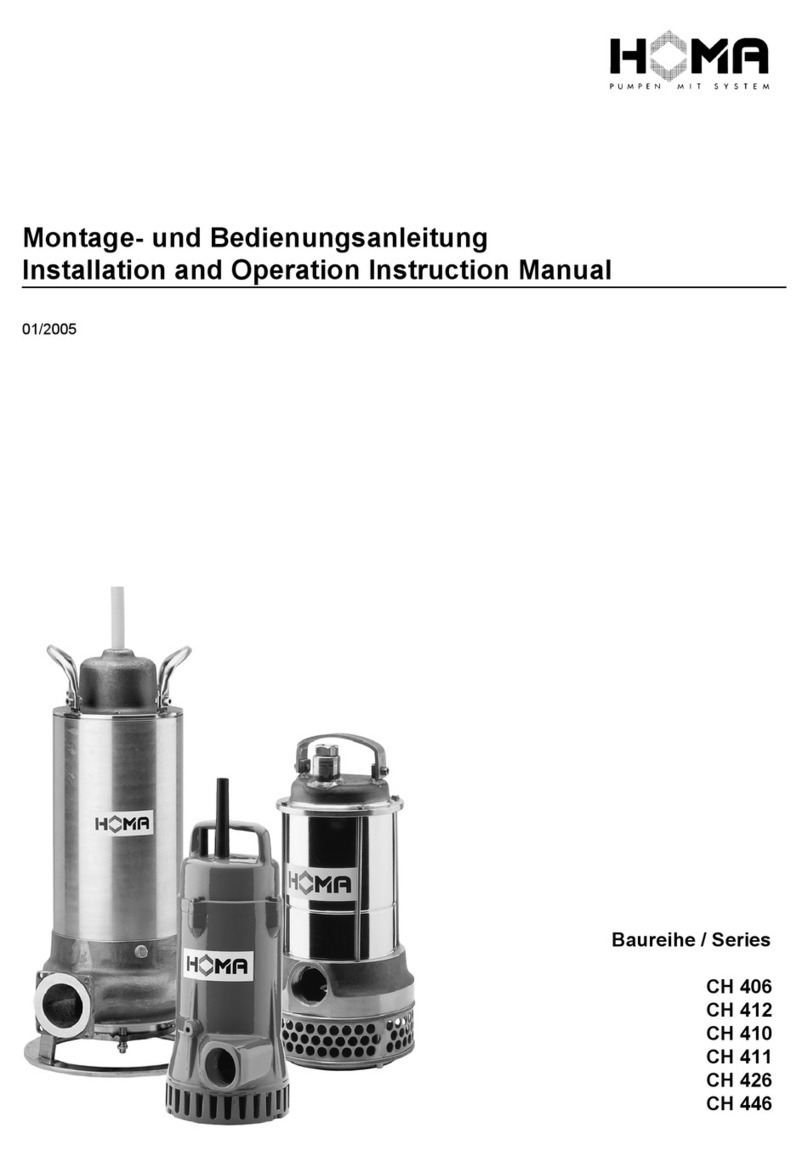
Homa
Homa CH 406 Series Installation and operation instruction
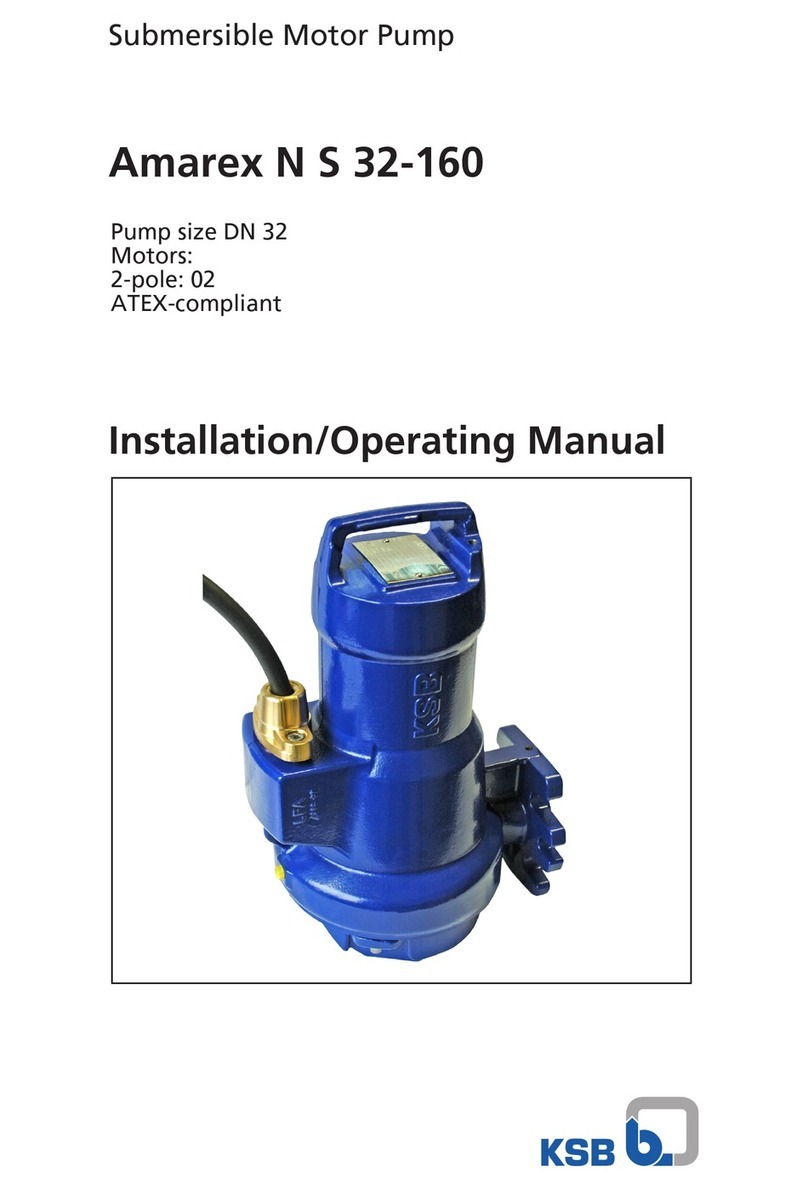
KSB
KSB Amarex N S 32-160 Installation & operating manual
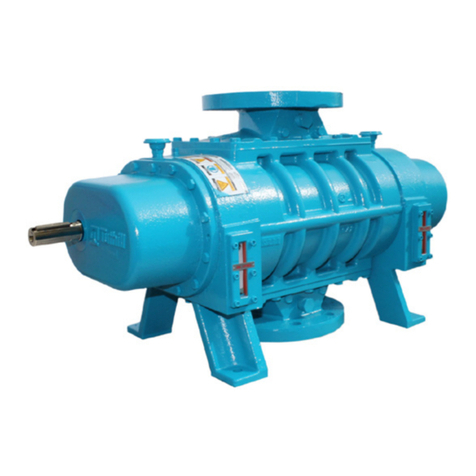
Tuthill
Tuthill M-D Pneumatics PD Plus operating manual
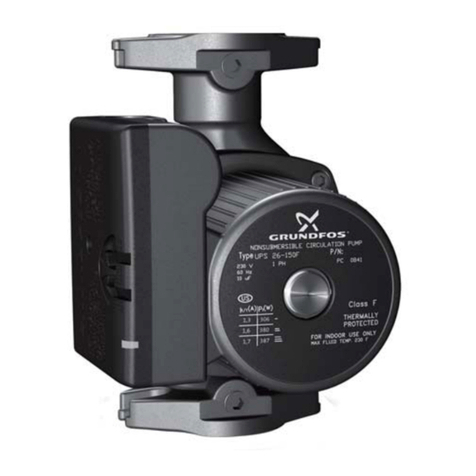
Grundfos
Grundfos UP XL Installation and operating instructions
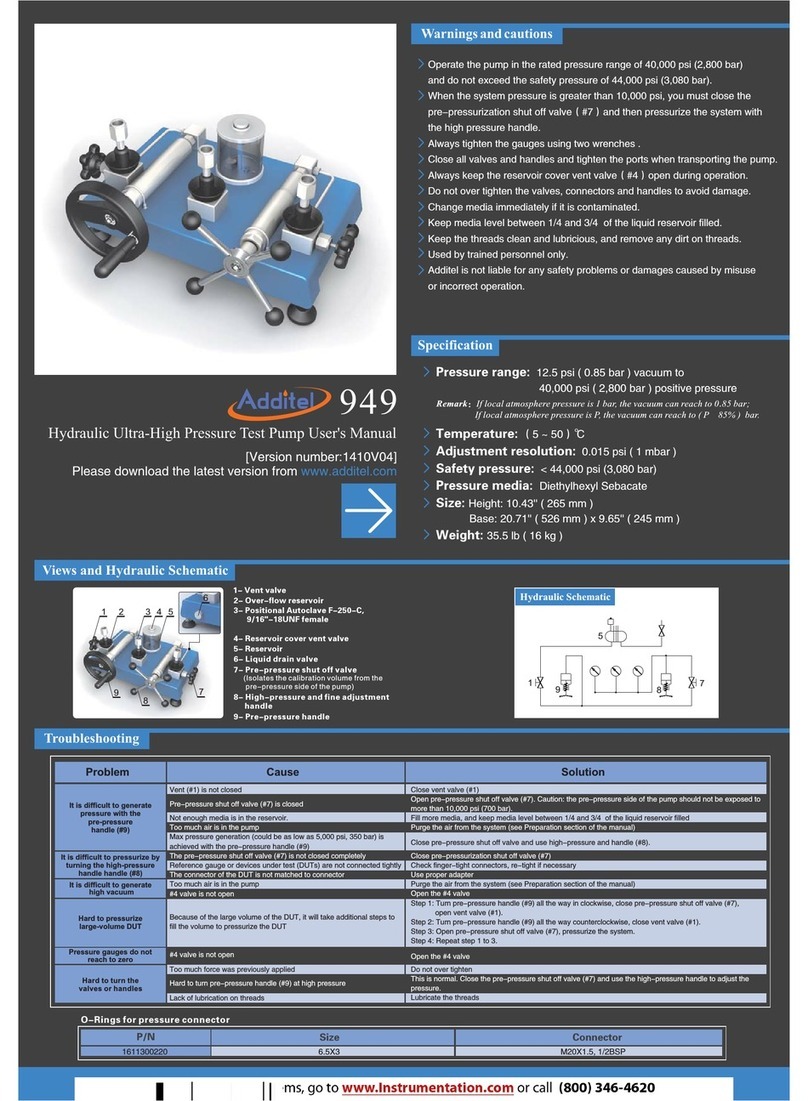
Additel
Additel 949 user manual
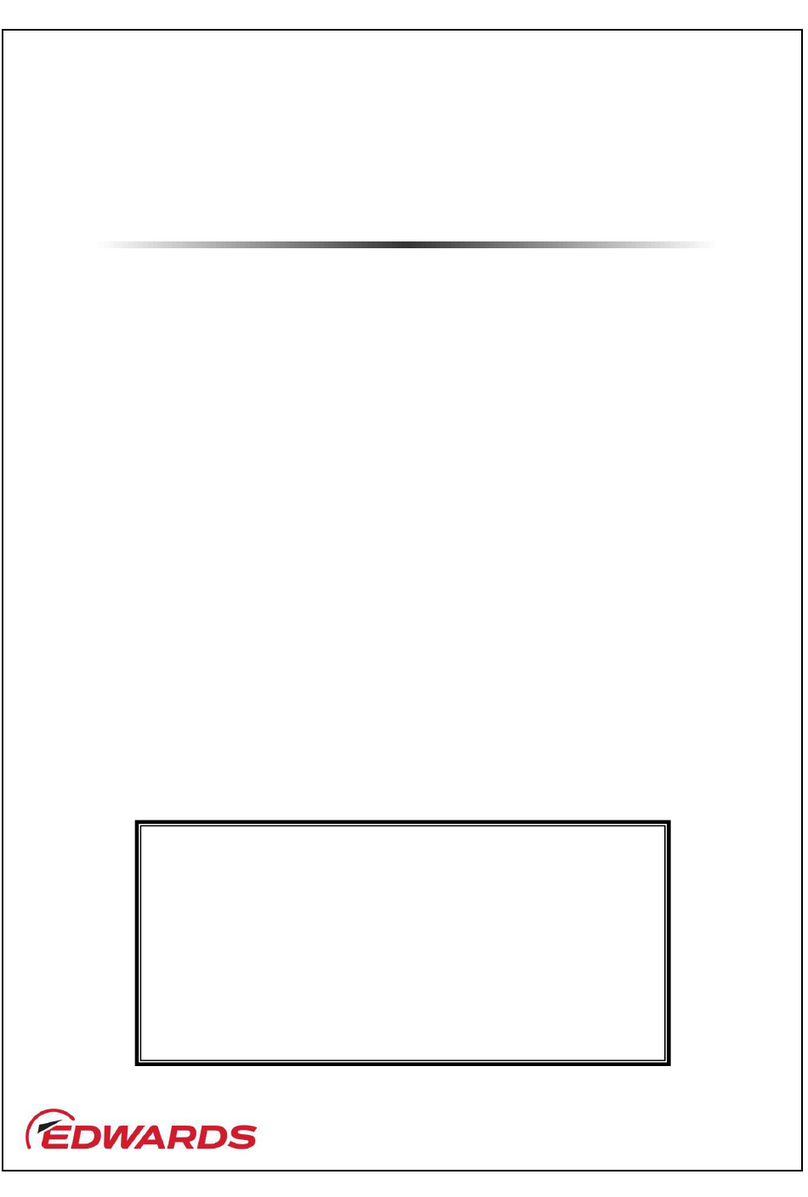
Edwards
Edwards STP Series instruction manual

